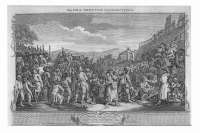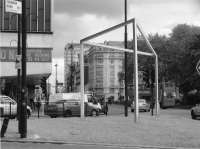Tyburn Tree
Proposal for a site-specific structure
Rick Buckley ©2006
‘Tyburn Tree’ is a site-specific (powder coated) steel structure. Elevated upon three vertical beams, measuring approx 6 metres in height. To stand at the original site of the infamous historical location for state executions, situated on a partially inaccessible traffic island (junction Edgeware Rd/Bayswater Rd). Currently only a small stone plaque marks the spot where the Tyburn- Tree (Tyburn Gallows) once stood.
Its structure consisted of a triangle supported by three uprights and three crossbeams, allowing for multiple hangings along each crossbeam. The place known today as Speakers Corner began life as a place for public executions. In particular Speakers Corner was home to the notorious Tyburn hanging tree. Established as a site for execution possibly as early as 1108. The first record of execution at Tyburn was in 1196. Situated in the north-east corner of Hyde Park, this place for state executions derived its name from a brook, which ran beneath Brook St: Tye Bourne. The junction of Tyburn Rd now (Oxford St) and Tyburn Lane now (Park Lane) provides its precise location. The Tyburn Gallows was erected in 1571, and stood alongside the Tyburn Stream until 1759, when the official place of execution for felons was moved to Newgate Prison, the site now occupied by the Old Bailey. The condemned were taken to Tyburn on a cart, and had to ride with the hangman and the prison Chaplin. Peace officers would lead the procession while immediately behind the cart marched a troop soldiers and behind them a posse of constables on horseback. The Procession passed through Holborn, St Giles and Tyburn Rd (Oxford St). Stops made at Inns on the way allowed prisoners the chance to indulge in a last drop or two of liquor, it is said that the term for abstinence ‘On the wagon’ is derived from such occasions. When finally at the gallows, the condemned were permitted to speak to the crowd, and these speeches often would be directed at the heart of the state. Catholics for example took advantage of the blurred division between treason and religion in their dying speech by embracing the authority of the monarchy but retaining open opposition to the Church of England. As such these martyrs opened up public theological debate. Some of those who listened to these speeches actually became convinced of their authenticity and converted to the Catholic cause. Speakers Corner evolved from these speeches, which attempted to explain, justify and or to simply give meaning to a life or lives. And so Tyburn developed into a political arena for public debate and discussion. That remains, the defining principles of speakers Corner rooted within a culture that was the Tyburn Hanging Tree.
Ref: Historic UK.com ©HUK
Tyburn Tree
Proposal for a site-specific structure
Rick Buckley ©2006
‘Tyburn Tree’ is a site-specific (powder coated) steel structure. Elevated upon three vertical beams, measuring approx 6 metres in height. To stand at the original site of the infamous historical location for state executions, situated on a partially inaccessible traffic island (junction Edgeware Rd/Bayswater Rd). Currently only a small stone plaque marks the spot where the Tyburn- Tree (Tyburn Gallows) once stood.
Its structure consisted of a triangle supported by three uprights and three crossbeams, allowing for multiple hangings along each crossbeam. The place known today as Speakers Corner began life as a place for public executions. In particular Speakers Corner was home to the notorious Tyburn hanging tree. Established as a site for execution possibly as early as 1108. The first record of execution at Tyburn was in 1196. Situated in the north-east corner of Hyde Park, this place for state executions derived its name from a brook, which ran beneath Brook St: Tye Bourne. The junction of Tyburn Rd now (Oxford St) and Tyburn Lane now (Park Lane) provides its precise location. The Tyburn Gallows was erected in 1571, and stood alongside the Tyburn Stream until 1759, when the official place of execution for felons was moved to Newgate Prison, the site now occupied by the Old Bailey. The condemned were taken to Tyburn on a cart, and had to ride with the hangman and the prison Chaplin. Peace officers would lead the procession while immediately behind the cart marched a troop soldiers and behind them a posse of constables on horseback. The Procession passed through Holborn, St Giles and Tyburn Rd (Oxford St). Stops made at Inns on the way allowed prisoners the chance to indulge in a last drop or two of liquor, it is said that the term for abstinence ‘On the wagon’ is derived from such occasions. When finally at the gallows, the condemned were permitted to speak to the crowd, and these speeches often would be directed at the heart of the state. Catholics for example took advantage of the blurred division between treason and religion in their dying speech by embracing the authority of the monarchy but retaining open opposition to the Church of England. As such these martyrs opened up public theological debate. Some of those who listened to these speeches actually became convinced of their authenticity and converted to the Catholic cause. Speakers Corner evolved from these speeches, which attempted to explain, justify and or to simply give meaning to a life or lives. And so Tyburn developed into a political arena for public debate and discussion. That remains, the defining principles of speakers Corner rooted within a culture that was the Tyburn Hanging Tree.
Ref: Historic UK.com ©HUK

